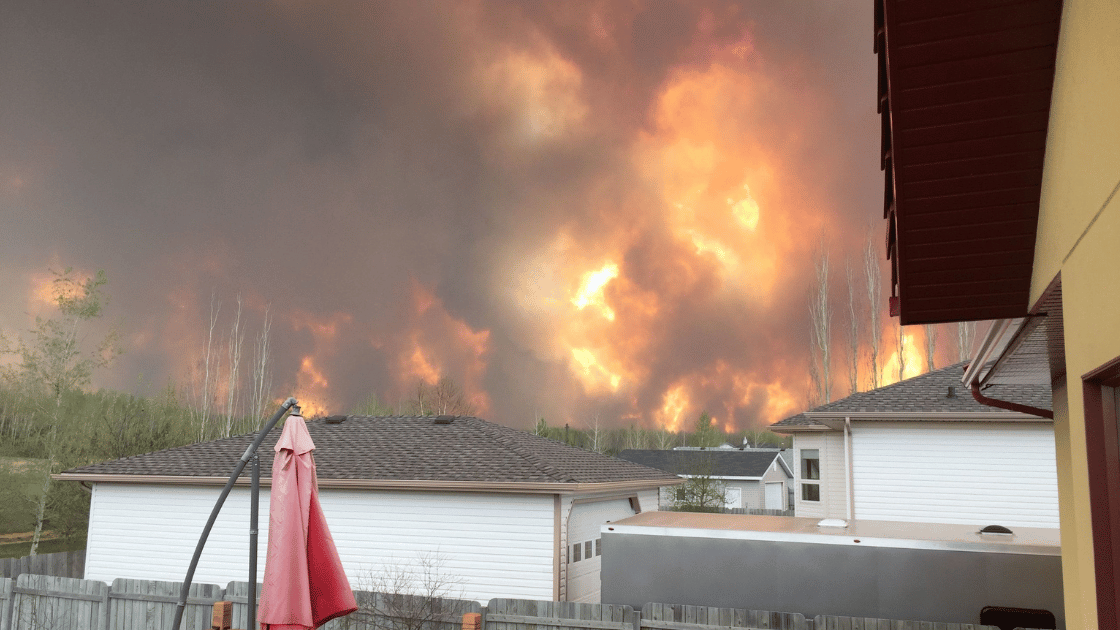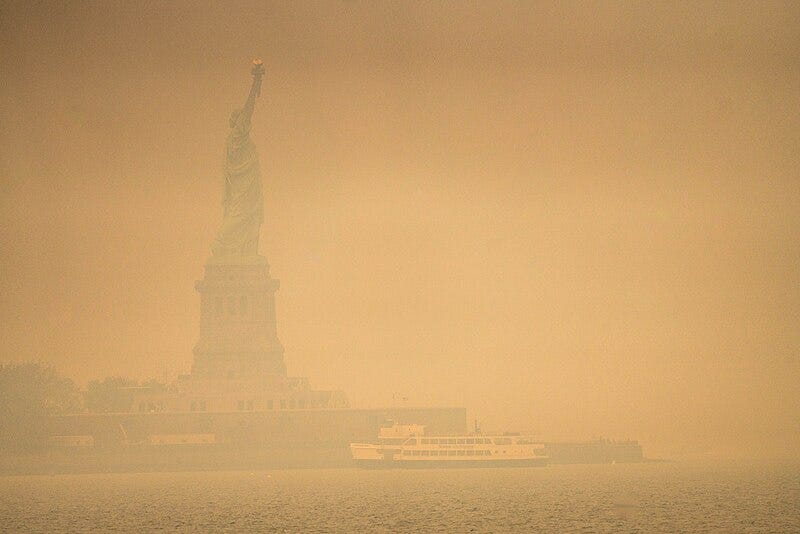Burning down the memory palace
The end of the world as we know it

The Book:
Fire Weather: A True Story from a Hotter World
By John Vaillant
Knopf
2023
The Talk:
“In the spring of 2016, halfway through the hottest year of the hottest decade in recorded history, a new kind of fire introduced itself to the world,” writes John Vaillant in the prologue to his 2023 book Fire Weather: A True Story from a Hotter World.
In dramatic, pulse-pounding detail, reminiscent of a book like Into Thin Air, Vaillant chronicles the community response to Alberta’s Fort McMurray fire, in which nearly 100,000 people were evacuated within hours and over 2,500 homes and buildings were destroyed. Ultimately, the fire burned for over a year, and became the most expensive disaster in Canadian history.
A new kind of fire
Fire is a natural phenomenon. Vaillant explains that fire on Earth would not exist without the oxygen that comes from living things. Even the trees of the boreal forests have evolved to burn. Fires happen every spring in the far north, and they are an essential part of a healthy boreal forest ecosystem.
But what has begun to appear in recent years—due to extremely high temperatures, extremely low humidity, and extremely high winds—are firestorms unlikely anything the world has seen before.
Under these conditions, helicopters cannot fly to fight the fires. Water from fire hoses evaporates before it even gets close to a flame. Emergency vehicles (and workers) must be constantly sprayed down with water in order to operate. Houses are incinerated to ash within 3-5 minutes, leaving nothing but a pile of nails. Even toilets and sinks vanish.
Vaillant describes how, during the 2009 Black Saturday Fires in Melbourne, Australia, “animals and people were killed by radiant heat alone, from hundreds of yards of away, as if they had been felled by a death ray.”
“We are beyond the normal scope of fire here,” writes Vaillant. “Familiar formulas do not apply. This is the kind of energy that does not burn but vaporizes, an energy more often associated with lasers, atom bombs, and suns.”
When experts attempt to calculate the energy released from these megafires, they use megatons. Many of the survivors used similar language.
Alone in his Jeep, creeping up 63 in the slowly flowing traffic jam with an anxious eye on his fuel gauge, Vandenbreekel was struck by how many vehicles were pulled over, some out of gas, others because their drivers were simply in shock, standing and staring back at the mushroom-shaped cloud blotting out their city. From a distance, Vandenbreekel said, “it looked like an atomic bomb had hit Fort McMurray.”
One fire expert Vaillant interviews compares the McMurray fire to Operation Gomorrah during World War II, when the Allies carpet-bombed Hamburg, Germany, for eight days with the specific intent of causing mass urban fires.
In addition to heat, there is the size. Out of these fires emerge what wildfire fighters call “dragons,” eruptions of combusting gas hundreds of feet high. Megafires can become so large they create their own weather and their own lighting which can start new fires. The 2018 Carr fire in California formed a tornado that lifted pickup trucks into trees while also burning them down to their springs. With everything burnt to ash or melted down, a survivor describes it like “a bomb, like Hiroshima.”
“Natural fire never did this,” explained the Cal Fire veteran Dusty Gyves after surveying the damage in around Redding. “It shouldn’t moonscape.”
The fire will make you forget
“Every day the world ends for someone, somewhere. Lately, this seems to be happening more often…”
When we think about climate change, it’s easy to forget what’s happened just a few years ago. The 2021 Greece fires were shocking at the time, though hardly mentioned today.
NBC chyron reads: MASSIVE WILDFIRE THREATENS ANCIENT SITES IN GREECE.
That was only two years ago.
Every summer the Northern Hemisphere turns into a horror show, from the Western U.S. to Europe to Asia, and we are surprised once again—seeing each individual “apocalyptic” event as a freak accident, each year as “aberrant.”
This is, of course, exactly how you might expect it to feel if every year was getting worse. Each year brings some new experience we can’t fit into the range of what’s normal. According to Cal Fire, nine of California’s twenty largest fires have occurred just since 2020. What we are experiencing—what we are about to experience—is both similar to the past and unlike anything we’ve experienced before.
When the apocalyptic/nuclear/atomic/death ray event has passed, we think we are reverting to “normal,” and yet often forget what we’ve lost—what is never coming back.
A memory palace is an imaginary place in your head where you put things you want to remember. It’s a memorization technique that works on the mind’s natural ability to think spatially.
Vaillant uses the idea of the memory palace a few times in the book, but inverts it:
…Palmer was becoming a stranger in his own hometown. This was happening now on a city-wide scale: the memory palace was burning down.
We all live in memory palaces—the physical spaces that contain our past, that mark the routines and habits that make up our lives, the environments that determine our identities. When our environment changes, we change. When the world around us burns down, the people we were burn down too.
Vaillant attempts to summarize the psychological effects of losing everything in a wildfire, based on his many interviews with survivors:
Left behind are juxtapositions so bizarre and disorienting that to describe them sounds like the mutterings of an insane person: garbage can puddle; melted guns on a platter; cars bleeding aluminum; piles of tire wire. Is this really where I lived, where I raised my children? Where did their beds go? Their bedrooms? The photos, the evidence? In their place, a void, the shadow of a burned tree where a kitchen table used to be, pools of once-familiar things gone molten, settled now into new forms, rigid and unrecognizable.
Living memory
And then there are the things it is time to forget. Over the course of the book Vaillant describes how firefighters of the new era have had to throw out the old rulebook. The old tactics, the old solutions, they no longer apply, no longer work.
One reason the Fort McMurray fire was so devastating was that, even though the warning signs were visible, it was so far out of the normal range at the time, it was simply unimaginable. Vaillant calls it the “Lucretius problem,” “the difficulty humans have imagining and assimilating things outside their own personal experience.” And yet fires like it, less than a decade afterward, are now typical (while the next step up is unimaginable for now).
The lesson from the fire: Forget how you thought nature was supposed to operate. Forget the planet of your childhood.
“By almost any measure,” writes Vaillant, “anyone born after 1990 is finding themselves in a new geological era, navigating a world fundamentally different from the one Baby Boomers and Gen Xers inherited. The chances of anyone alive today experiencing a year as relatively cool as 1996 are effectively nil.”
Because the climate is changing, we are becoming different people. The old versions of us won’t be coming back. Massive wildfire threatens ancient sites in Greece. We are losing the planet that shaped us, that shaped our cultures, our religions, our values, our definition of happiness, our collective dreams. All these will soon become pictures in a book of places no one can visit.
The real turns imaginary as the unimaginable becomes real.

Related:
Climate change is my family's life now
Yellowknife awakens to grossest morning in city history (Cabin Radio, 09/23/23)
Escaping underground: the eerie new age of bushfire bunkers (Guardian, 10/28/23)
California wildfires created toxic chromium, research finds (NBC News, 12/12/23)

We live in an age of hyperbole where the words "awesome" and "terrible" are overused to the point of being meaningless. We are relearning what they mean the hard way.